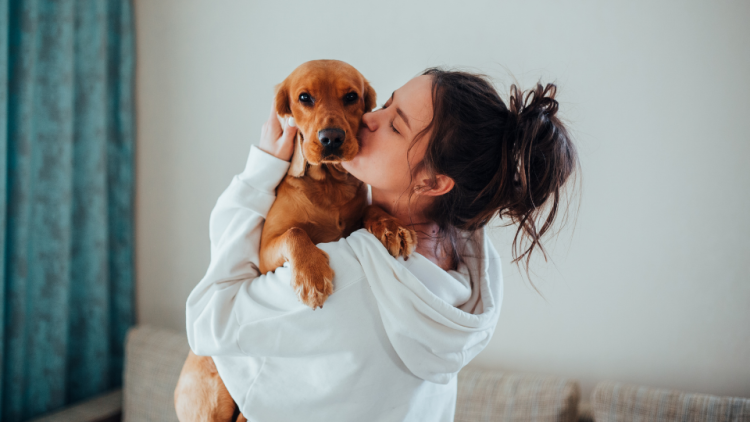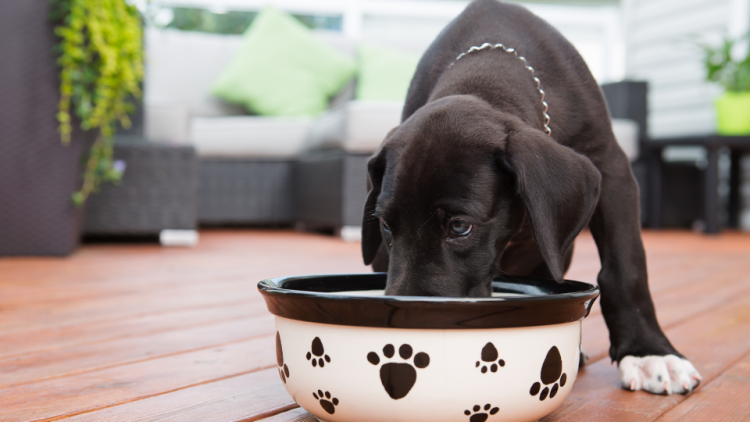As a pet parent, you’ll want to get your new puppy started off on the right paw. Feeding your puppy an appropriate diet will ensure healthy growth and can help to prevent obesity and other health problems. All puppies should be fed a diet formulated for growth, but if you’ve added a giant or large breed puppy to your family, there's additional information that's crucial for you to know.
Get The New Puppy Checklist Why Large Breed Dogs Need Pet Insurance
In this article, we will discuss considerations for choosing the best large breed puppy food, how much food to feed a large breed puppy, when to stop feeding puppy food to large breeds, and more.
Use the links below for quick answers to your questions about large breed puppy dog food:
- What’s considered a large breed puppy?
- Do large breed puppies have special nutritional needs?
- What’s the best large breed puppy food?
- How to find the best large breed puppy food?
- How many cups of food for a large breed puppy?
- When to stop feeding puppy food to large breeds?
- Can my large breed puppy have treats or human food?
- Do I have to buy large breed puppy food?
- Key Takeaways
What’s considered a large breed puppy?
The Association of American Feed Control Officers (AAFCO) defines large breed puppies as dogs that are expected to exceed seventy pounds at their healthy adult weight. It is worth noting that some nutritionists recommend using fifty pounds as the cut-off for large breed dogs to ensure the dog receives appropriate nutrition.
There is no strict cut-off to distinguish between large and giant breeds. Popular large breed dogs include the Labrador Retriever, Golden Retriever, Boxer, and German Shepherd. Giant breed dogs will reach larger adult sizes, often over 100 pounds. Popular giant breeds include the Saint Bernard, English Mastiff, and Great Dane.
The good news for pet owners is that nutritional needs for large and giant breed puppies are similar, so we don’t need to get hung up on differentiating the two groups. Large breed puppy foods are appropriate for both large and giant breed puppies.

Do large breed puppies have special nutritional needs?
Because dogs grow rapidly from a few pounds at birth to their adult size within the first one to two years of life, it is important that they receive enough calories and nutrients to help them grow at an appropriate rate. If a pet food contains too much or too little of certain minerals, like calcium and phosphorus, or other ingredients, like protein and fat, it can lead to health problems such as obesity and developmental orthopedic diseases.
For large and giant breed dogs that grow faster, larger, and longer than small and medium dogs, the total calories and calcium levels of the food are especially important. Large breed puppy foods have lower calories and different calcium and phosphorus levels than traditional puppy diets.
This allows the puppies to receive the needed nutrients for growth without overfeeding calories, which can lead to obesity and exacerbate many health conditions, including orthopedic disease. The narrower acceptable calcium levels ensure that bones do not grow too quickly at any given time.
What is the best large breed puppy food?
With so many options on the market, it can be a daunting task to choose the best food for dogs. In general, you’ll want to choose a dog food formula that meets the following criteria, as recommended by the World Small Animal Veterinary Association’s Global Nutrition Council:
- **Formulated for growth or all life stages (bonus if it is specifically stated to be formulated for large breed dogs)
- **Undergone feeding trials following AAFCO guidelines
- **Have a veterinary nutritionist on staff
- **Have an experienced pet food formulator on staff (this is not necessarily a veterinarian)
- **Have effective quality control of the manufacturing process to ensure pet food safety
Each individual may also have preferences for certain kibble shapes, sizes, and flavors. This means you may have to try multiple diets to find the best diet for your puppy. If you are switching between different foods, it is important to do a slow transition between diets to avoid an upset stomach in dogs.
How to find the best large breed puppy food?
As you compare different formulas to find the best large breed puppy food that works for both you and your pet, remember to check for the following qualifications to ensure you go home with a high-quality formula designed with your pet’s specific needs in mind:
- Look for the nutritional adequacy statement on the label. The best large breed puppy food will tell you the formula is “complete and balanced”, meaning it contains all of the necessary nutrients (“complete”) in the appropriate ratios (“balanced”) for the indicated life stage.
- All puppies should be fed a diet labeled for growth or all life stages. Some diets may more specifically state “growth including large breed dogs” or “growth except for puppies over 70 pounds.”

How many cups of food for a large breed puppy?
Most large breed puppies consume two to four cups of food divided into three or four meals per day, depending on the recommended serving suggestion for your pet’s weight and age on the package label. However, the provided recommendation is only a loose guideline, and you should adjust the amount of food intake to maintain an ideal body condition.
It’s essential that your puppy maintain a healthy body weight throughout its life. Excess weight can stress joints and lead to orthopedic disease as well as predispose to other diseases, such as Diabetes, and shorten the lifespan of your pet.
Your veterinarian can calculate the number of daily calories that your pet needs to maintain its current body condition if it is healthy. They can also help to guide you in the number of calories your pet should receive if they are under- or overweight.
At each visit, your veterinarian will evaluate your pet’s body condition score, which evaluates the overall amount of fat your pet carries. At an ideal score (4-5 on a scale of 9), your pet’s ribs should be able to be felt with gentle pressure, a waist is present when your pet is viewed from above, and the abdomen slopes up toward the hindlimbs (called an abdominal tuck) when your pet is viewed from the side. You can evaluate your pet’s body condition score regularly at home and adjust feeding amounts to maintain an ideal condition.
When to stop feeding puppy food to large breeds?
How long to feed large breed puppy food will depend on your pet’s growth rate, as all puppies should eat a diet labeled for “growth” or “all life stages” until they reach their adult size (or skeletal maturity). For large and giant breed dogs, this may not occur until 18 to 24 months of age.
Even if your pet is spayed or neutered prior to this age, continue feeding a large breed puppy food to ensure that your dog is receiving the appropriate nutrients for growth. However, caloric needs decrease after spay and neuter, so you should reduce the total amount you are feeding after surgery. Remember that the ultimate goal is to maintain a lean body condition to maximize the length and quality of your pet’s life.
Can my large breed puppy have treats or human food?
You can give your puppy treats in moderation — they’re often an important part of positive reinforcement when training a puppy. It can be tempting to give your puppy human foods as a way of bonding, but this can create bad habits that are hard to break later in life.
Remember that all treats and human foods have calories, which can add up quickly and result in your pet becoming overweight or obese. Veterinary nutritionists recommend that treats and supplemental foods make up less than 10% of the daily caloric intake to ensure that the pet receives the appropriate nutrient levels.
If you really want to treat your puppy to some human foods, consider using fruits and/or vegetables which are usually lower in calories. If you need more “treats” to use for training, you can set some of your puppy’s daily kibble allotment aside to use as a food reward during training sessions.
Do I have to buy large breed puppy food?
Without a specially formulated large breed puppy food, your growing pet may not receive appropriate nutrition, and he or she may become overweight or suffer from developmental orthopedic diseases, such as hypertrophic osteodystrophy (HOD) and panosteitis.
Signs of developmental orthopedic diseases in large breed puppies may include:
- Limping or favoring one or more limbs when walking
- Fever
- Differences in the appearance of the limbs
- Difficulty running, jumping, or climbing stairs
If your pet shows any of these symptoms, they should be evaluated by a veterinarian immediately. The sooner these diseases are diagnosed, the easier they are to treat.
While having a pet insurance policy won’t cover the cost of dog food for your large breed puppy, it can help to provide a financial safety net in the event that your pet develops an orthopedic disease. Learn more about why large dog breeds need pet insurance and how you can save money while keeping your pet happy and healthy at Pawlicy Advisor.
Protect Your Puppy with Pet Insurance See the Full List of Safe & Unsafe Food For Dogs
Key Takeaways
- All puppies should be fed a diet labeled for growth or “all life stages” to ensure they have the appropriate calories and nutrients for healthy growth.
- Any puppy that is expected to weigh more than 50 to 70 pounds as a healthy adult should be fed large breed puppy food. These foods are lower in calories and have more strict calcium requirements than regular puppy foods to help optimize growth rates.
- Large and giant breed puppies should be fed a large breed puppy food until they reach skeletal maturity, which may not occur until 18 to 24 months of age.
- Your puppy should be fed an amount of food that maintains a lean body condition throughout its life.
